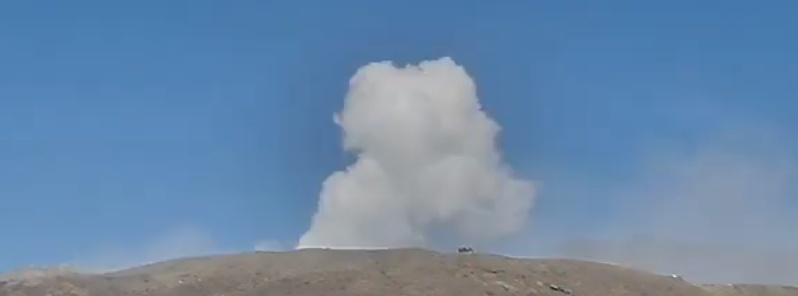Eruption at Asosan, the first since October 2016 , Japan

The Japanese Asosan volcano erupted at 09:28 UTC (18:28 LT) on April 16, 2019. It was its first eruption since October 8, 2016. The Alert Level was raised to 2 on April 14.
At one point, the volcanic ash reached 200 m (656 feet) above the crater (1 792 m / 5 880 feet above sea level), but the Japan Meteorological Agency said the eruption was not continuing as of 10:00 UTC.
Volcanic earthquakes accompanied by a large volume of volcanic gas at the volcano started intensifying at about 13:30 JST on April 14, forcing JMA to raise the Alert Level from 1 to 2.
Entry within 1 km (0.62 miles) of the No. 1 crater of the Nakadake peak was restricted by local authorities.

The last major eruption at the volcano took place on October 8, 2016. It produced a column of ash up to 11 km (36 000 feet) above sea level and sent large boulders down the slopes of the volcano.
Ash rained down on cars, houses and roads in the city Aso and was reported as far as 320 km (200 miles) from the crater.
Farmers reported that some vinyl greenhouses where tomatoes and asparagus were being grown 6 – 8 km (4 – 5 miles) away from the crater had been broken by ash and small rocks.
A window was also cracked by a falling rock at an Aso youth center about 5 km (3 miles) away from the crater.
This was the first explosive eruption at the volcano since 1989. It came 6 months after a series of earthquakes shook Kumamoto Prefecture.


2016 eruption. Video courtesy AP
Geological summary
The 24-km-wide Asosan caldera was formed during four major explosive eruptions from 300 000 to 90 000 years ago. These produced voluminous pyroclastic flows that covered much of Kyushu. The last of these, the Aso-4 eruption, produced more than 600 km3 of airfall tephra and pyroclastic-flow deposits. A group of 17 central cones was constructed in the middle of the caldera, one of which, Nakadake, is one of Japan's most active volcanoes. It was the location of Japan's first documented historical eruption in 553 AD.
The Nakadake complex has remained active throughout the Holocene. Several other cones have been active during the Holocene, including the Kometsuka scoria cone as recently as about 210 CE. Historical eruptions have largely consisted of basaltic to basaltic-andesite ash emission with periodic strombolian and phreatomagmatic activity. The summit crater of Nakadake is accessible by toll road and cable car, and is one of Kyushu's most popular tourist destinations. (GVP)
Featured image credit: Hondo Kyoto University, VolcanoYT

Commenting rules and guidelines
We value the thoughts and opinions of our readers and welcome healthy discussions on our website. In order to maintain a respectful and positive community, we ask that all commenters follow these rules.